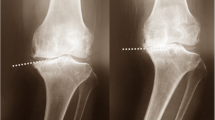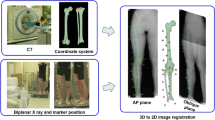Abstract
Purpose
Whether the inclined articular surface on the medial proximal tibia and the external knee adduction moment (KAM) correlate remains unclear. The hypothesis was that a steeper inclined articular surface correlated with a larger KAM in advanced knee osteoarthritis (OA).
Methods
A total of 44 females (non-OA, 9 knees; early OA, 14 knees; advanced OA, 21 knees; mean age, 58 ± 16 years) were examined. Three-dimensional (3D) assessment was used on biplanar long-leg radiographs and 3D bone models using a 3D to 2D image registration technique. The approximation plane in the proximal tibia was determined using the least-square method. The joint moments were mathematically calculated in a gait analysis, applying a motion capture system and force plates. The main evaluation parameters were the femorotibial angle (FTA), the coronal inclination of the approximation plane in the medial proximal tibia (coronal inclination), and internal knee joint moments. The KAM means the external moments balanced with the internal knee abduction moments.
Results
The advanced OA showed a larger internal abduction moment (p = 0.017) at the loading response than the other groups. The larger FTA and steeper coronal inclination correlated with the larger internal abduction moment (FTA, p < 0.001; coronal inclination, p = 0.003) at the loading response.
Conclusions
As the clinical relevance, the association among the coronal inclination of the medial proximal tibia, lower extremity alignment, and KAM is one of the key factors to help better understand the etiology of knee OA.
Level of evidence
III.




Similar content being viewed by others
References
Akai M, Doi T, Fujino K, Iwaya T, Kurosawa H, Nasu T (2005) An outcome measure for Japanese people with knee osteoarthritis. J Rheumatol 32:1524–1532
Andriacchi TP, Johnson TS, Hurwitz DE (2005) Musculoskeletal dynamics locomotion, and clinical applications. In: Mow VC, Huiskes R (eds) Basic orthopaedics and mechano-biology, 3rd edn. Lippincott Williams & Wilkins, Philadelphia, pp 90–121
Bellamy N, Buchanan WW, Goldsmith CH, Campbell J, Stitt LW (1988) Validation study of WOMAC: a health status instrument for measuring clinically important patient relevant outcomes to antirheumatic drug therapy in patients with osteoarthritis of the hip or knee. J Rheumatol 16:494–502
Chang AH, Moisio KC, Chmiel JS, Eckstein F, Guermazi A, Prasad PV, Zhang Y, Almagor O, Belisle L, Hayes K, Sharma L (2015) External knee adduction and flexion moments during gait and medial tibiofemoral disease progression in knee osteoarthritis. Osteoarthr Cartil 23:1099–1106
Foroughi N, Smith R, Vanwanseele B (2009) The association of external knee adduction moment with biomechanical variables in osteoarthritis: a systematic review. Knee 16:303–309
Higano Y, Hayami T, Omori G, Koga Y, Endo K, Endo N (2016) The varus alignment and morphologic alterations of proximal tibia affect the onset of medial knee osteoarthritis in rural Japanese women: case control study from the longitudinal evaluation of Matsudai Knee osteoarthritis survey. J Orthop Sci 21:166–171
Hirschmann MT, Moser LB, Amsler F, Behrend H, Leclerq V, Hess S (2019a) Phenotyping the knee in young non-osteoarthritic knees shows a wide distribution of femoral and tibial coronal alignment. Knee Surg Sports Traumatol Arthrosc 27:1385–1393
Hirschmann MT, Moser LB, Amsler F, Behrend H, Leclerq V, Hess S (2019b) Functional knee phenotypes: a novel classification for phenotyping the coronal lower limb alignment based on the native alignment in young non-osteoarthritic patients. Knee Surg Sports Traumatol Arthrosc 27:1394–1402
Hollister AM, Jatana S, Singh AK, Sullivan WW, Lupichuk AG (1993) The axes of rotation of the knee. Clin Orthop Relat Res 290:259–268
Ishii Y, Noguchi H, Sato J, Ishii H, Todoroki K, Toyabe S (2018) Medial and lateral laxity in knees with advanced medial osteoarthritis. Osteoarthr Cartil 26:666–670
Kobayashi K, Sakamoto M, Tanabe Y, Ariumi A, Sato T, Omori G, Omori G, Koga Y (2009) Automated image registration for assessing three-dimensional alignment of entire lower extremity and implant position using bi-plane radiography. J Biomech 42:2818–2822
Koga Y (2008) Osteoarthritic of the knee: epidemiology, biomechanics, and conservative treatment [In Japansese] Chapter 2:41–65
Maly MR, Acker SM, Totterman S, Tamez-Peña J, Stratford PW, Callaghan JP, Adachi JD, Beattie KA (2015) Knee adduction moment relates to medial femoral and tibial cartilage morphology in clinical knee osteoarthritis. J Biomech 48:3495–3501
Marriott KA, Birmingham TB, Leitch KM, Pinto R, Giffin JR (2019) Strong independent associations between gait biomechanics and pain in patients with knee osteoarthritis. J Biomech 94:123–129
Matsumoto T, Hashimura M, Takayama K, Ishida K, Kawakami Y, Matsuzaki T, Nakano N, Matsushita T, Kuroda R, Kurosaka M (2015) A radiographic analysis of alignment of the lower extremities–initiation and progression of varus-type knee osteoarthritis. Osteoarthr Cartil 23:217–223
Miyazaki T, Wada M, Kawahara H, Sato M, Baba H, Shimada S (2002) Dynamic load at baseline can predict radiographic disease progression in medial compartment knee osteoarthritis. Ann Rheum Dis 61:617–622
Mochizuki T, Tanifuji O, Koga Y, Sato T, Kobayashi K, Nishino K, Watanabe S, Ariumi A, Fujii T, Yamagiwa H, Omori G, Endo N (2017) Sex differences in femoral deformity determined using three-dimensional assessment for osteoarthritic knees. Knee Surg Sports Traumatol Arthrosc 25:468–476
Mochizuki T, Tanifuji O, Koga Y, Hata R, Mori T, Nishino K, Sato T, Kobayashi K, Omori G, Sakamoto M, Tanabe Y, Endo N (2017) External torsion in a proximal tibia and internal torsion in a distal tibia occur independently in varus osteoarthritic knees compared to healthy knees. J Orthop Sci 22(3):501–505
Mochizuki T, Tanifuji O, Koga Y, Sato T, Kobayashi K, Watanabe S, Fujii T, Yamagiwa H, Katsumi R, Koga H, Omori G, Endo N (2018) Correlation between posterior tibial slope and sagittal alignment under weight-bearing conditions in osteoarthritic knees. PLoS ONE 13:e0202488
Mochizuki T, Koga Y, Tanifuji O, Sato T, Watanabe S, Koga H, Kobayashi K, Omori G, Endo N (2019) Effect on inclined medial proximal tibial articulation for varus alignment in advanced knee osteoarthritis. J Exp Orthop 6:14
Mochizuki T, Koga Y, Mori T, Nishino K, Kobayashi K, Tanifuji O, Sato T, Katsumi R, Koga H, Omori G, Tanabe Y (2019) Articular surface of the medial proximal tibia is aligned parallel to the ground in three-dimensional space under weight-bearing conditions in healthy and varus osteoarthritic knees. Knee Surg Sport Traumatol Arthrosc. https://doi.org/10.1016/j.arth.2018.02.009
Nie Y, Wang H, Xu B, Zhou Z, Shen B, Pei F (2019) The relationship between knee adduction moment and knee osteoarthritis symptoms according to static alignment and pelvic drop. Biomed Res Int. https://doi.org/10.1155/2019/7603249
Nishino K, Omori G, Koga Y, Kobayashi K, Sakamoto M, Tanabe Y, Tanaka M, Arakawa M (2015) Three-dimensional dynamic analysis of knee joint during gait in medial knee osteoarthritis using loading axis of knee. Gait Posture 42:127–132
Nishino K, Yamamoto N, Tanaka M, Ohishi T, Tanaka Y, Okamura N, Sekine H, Arakawa M, Omori G (2020) Effect of throwing kinematics and kinetics on different ranges of long toss in youth baseball players. Multidiscip Digit Publ Inst Proc 49:118. https://doi.org/10.3390/proceedings2020049118
Sato T, Koga Y, Omori G (2004) Three-dimensional lower extremity alignment assessment system: application to evaluation of component position after total knee arthroplasty. J Arthroplasty 19:620–628
Takeuchi H (2019) Gait- and postural-alignment-related prognostic factors for hip and knee osteoarthritis: toward the prevention of osteoarthritis progression. Phys Ther Res 22:31–37
Telfer S, Lange MJ, Sudduth ASM (2017) Factors influencing knee adduction moment measurement: a systematic review and meta-regression analysis. Gait Posture 58:333–339
Thorlund JB, Holsgaard-Larsen A, Creaby MW, Jørgensen GM, Nissen N, Englund M, Lohmander LS (2016) Changes in knee joint load indices from before to 12 months after arthroscopic partial meniscectomy: a prospective cohort study. Osteoarthr Cartil 24:1153–1159
Tokuda K, Anan M, Takahashi M, Sawada T, Tanimoto K, Kito N, Shinkoda K (2018) Biomechanical mechanism of lateral trunk lean gait for knee osteoarthritis patients. J Biomech 66:10–17
Funding
This study received KAKENHI from grants-in-aid for scientific research in Japan society for the promotion of science.
Author information
Authors and Affiliations
Corresponding author
Ethics declarations
Conflict of interest
The authors received and will not receive any benefits or funding from any commercial party related directly or indirectly to the subject of this article.
Ethical approval
All procedures performed in studies involving human participants were in accordance with the ethical standards of the institutional and/or national research committee and with the 1964 Helsinki declaration and its later amendments or comparable ethical standards.
Additional information
Publisher's Note
Springer Nature remains neutral with regard to jurisdictional claims in published maps and institutional affiliations.
Electronic supplementary material
Below is the link to the electronic supplementary material.
Rights and permissions
About this article
Cite this article
Mochizuki, T., Omori, G., Nishino, K. et al. The medial inclination of the proximal tibia is associated with the external knee adduction moment in advanced varus knee osteoarthritis. Knee Surg Sports Traumatol Arthrosc 30, 574–583 (2022). https://doi.org/10.1007/s00167-020-06323-8
Received:
Accepted:
Published:
Issue Date:
DOI: https://doi.org/10.1007/s00167-020-06323-8




